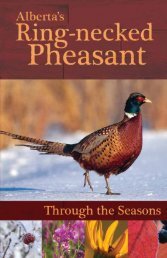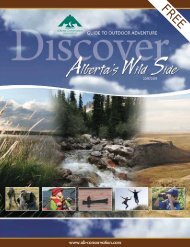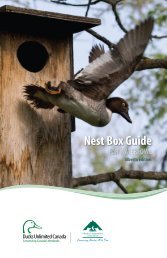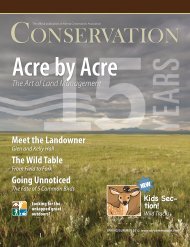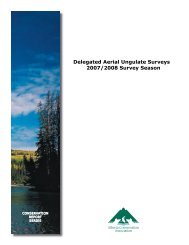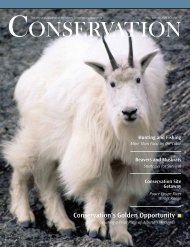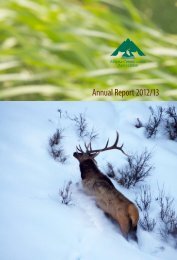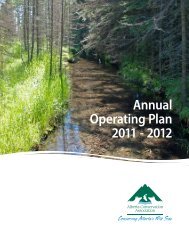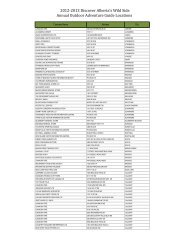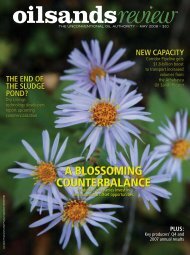Abundance and Distribution of Arctic Grayling in the Upper Little ...
Abundance and Distribution of Arctic Grayling in the Upper Little ...
Abundance and Distribution of Arctic Grayling in the Upper Little ...
You also want an ePaper? Increase the reach of your titles
YUMPU automatically turns print PDFs into web optimized ePapers that Google loves.
summer <strong>of</strong> 2007 to estimate abundance <strong>of</strong> <strong>Arctic</strong> grayl<strong>in</strong>g <strong>in</strong> <strong>the</strong> upper <strong>Little</strong> Smoky<br />
River <strong>in</strong> order to provide resource managers with current data that will aid <strong>in</strong> <strong>the</strong><br />
development <strong>of</strong> management plans for <strong>the</strong> <strong>Little</strong> Smoky watershed.<br />
1.2. Study objectives<br />
Our study addressed <strong>the</strong> follow<strong>in</strong>g objectives:<br />
i. Us<strong>in</strong>g sample angl<strong>in</strong>g, calculate catch rates <strong>of</strong> <strong>Arctic</strong> grayl<strong>in</strong>g (≥ 150 mm<br />
fork length; FL) <strong>and</strong> legal‐sized <strong>Arctic</strong> grayl<strong>in</strong>g (> 350 mm TL) at 29<br />
locations distributed along a 235‐km section <strong>of</strong> <strong>the</strong> upper <strong>Little</strong> Smoky<br />
River;<br />
ii.<br />
At a subset <strong>of</strong> locations (n = 7), estimate angl<strong>in</strong>g capture efficiency <strong>of</strong><br />
<strong>Arctic</strong> grayl<strong>in</strong>g us<strong>in</strong>g capture‐mark‐recapture (CMR) techniques; we<br />
def<strong>in</strong>ed efficiency as <strong>the</strong> proportion (or percentage) <strong>of</strong> fish <strong>in</strong> a given<br />
area that were captured dur<strong>in</strong>g sampl<strong>in</strong>g;<br />
iii.<br />
Model abundance <strong>and</strong> spatial distribution <strong>of</strong> <strong>Arctic</strong> grayl<strong>in</strong>g, <strong>in</strong>clud<strong>in</strong>g<br />
legal‐sized <strong>Arctic</strong> grayl<strong>in</strong>g, for <strong>the</strong> entire study area <strong>in</strong> <strong>the</strong> <strong>Little</strong> Smoky<br />
River ma<strong>in</strong>stem; <strong>and</strong><br />
iv.<br />
Determ<strong>in</strong>e <strong>the</strong> size structure <strong>of</strong> <strong>the</strong> <strong>Arctic</strong> grayl<strong>in</strong>g population <strong>in</strong> <strong>the</strong><br />
<strong>Little</strong> Smoky River study area.<br />
2.0 STUDY AREA<br />
The <strong>Little</strong> Smoky River is located <strong>in</strong> west‐central Alberta <strong>and</strong> flows approximately 550<br />
km from its headwaters <strong>in</strong> <strong>the</strong> East Slopes <strong>of</strong> Alberta to its confluence with <strong>the</strong> Smoky<br />
River. The upper third <strong>of</strong> <strong>the</strong> river is characterized by moderate gradient, abundant<br />
aquatic vegetation <strong>and</strong> clear but slightly sta<strong>in</strong>ed water (Sterl<strong>in</strong>g <strong>and</strong> Hunt 1989). Sport<br />
fish species <strong>in</strong> <strong>the</strong> upper <strong>Little</strong> Smoky River <strong>in</strong>clude <strong>Arctic</strong> grayl<strong>in</strong>g, mounta<strong>in</strong><br />
2





